-
Views
-
Cite
Cite
Darryl Chalk, Rebecca Totaro and Ernest B. Gilman (eds), Representing the Plague in Early Modern England, Social History of Medicine, Volume 25, Issue 1, February 2012, Pages 259–260, https://doi.org/10.1093/shm/hkr149
Close - Share Icon Share
Extract
To those who suffered through the ravages of the bubonic plague in early modern England, the disease was as mysterious as it was ubiquitous. The chasm between its actual mode of transmission and medical attempts to understand it gave the plague a powerful presence in the social imaginary of this period. As Susan Sontag once put it, ‘Any important disease whose causality is murky, and for which treatment is ineffectual, tends to be awash in significance’ (Illness as Metaphor and AIDS and Its Metaphors, Doubleday, 1990, p. 58). Representations of the plague thus took on a variety of forms, shifting their shape as much as this seemingly mutable disease eluded early modern attempts to know it. The essays in this collection make significant strides towards mapping the diversity of literary responses to plague epidemics, and offer valuable insights into the ways in which earlier cultures dealt with collective traumatic experiences. Part of a recent upsurge in studies of the representation of illness and disease in early modern literature, the collection arrives in the wake of its editors' own excellent contributions to this field – Totaro's Suffering in Paradise: The Bubonic Plague in English Literature from More to Milton (Duquesne University Press, 2005) and Gilman's Plague Writing in Early Modern England (University of Chicago Press, 2009) – but also follows the work of a range of scholars interested in disease as a discursive phenomenon in early modern English culture such as Michael Neill, Jonathan Gil Harris, Margaret Healy and Bryon L. Grigsby.




